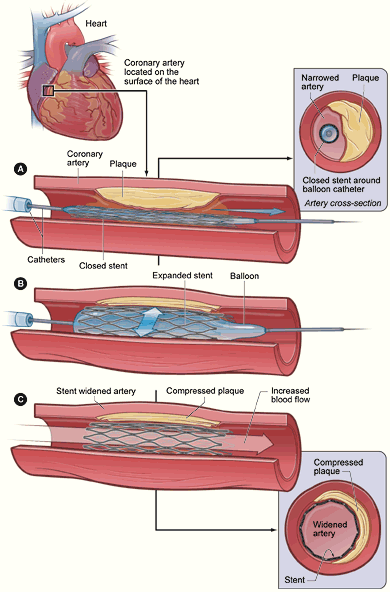Angina is severe chest pain resulting from myocardial ischemia. It is caused by inadequate myocardial blood and oxygen supply, obstruction of coronary blood flow, coronary artery spasm, and a condition that increases myocardial oxygen demand. There is an imbalance between oxygen supply and demand.
The treatment is focused to provide relief of an acute attack, correct the imbalance between myocardial oxygen supply and demand, and prevent the progression of the disease and further attack to reduce risk of myocardial infarction.
Types of Angina:- Stable Angina: it is also called exertional angina, occurs with activities that involve exertion or emotional stress and is relieved with rest or nitroglycerin. It has stable pattern of onset, duration, severity, and relieving factors.
- Unstable Angina: it is also called preinfarction angina, occurs with an unpredictable degree of exertion or emotion and increases in occurrence, duration and severity over time. The pain of this angina may not be relieved with nigroglycerin.
- Variant Angina: it is also called Prinzmetal’s or vasospastic angina. It is results from coronary artery spasm and may occur at rest. ST segment elevation is noted on the electrocardiogram.
- Intractable Angina: it is a chronic and incapacitating angina that is unresponsive to interventions.
- Preinfarction Angina: It is associated with acute coronary insufficiency and lasts longer that 15 minutes. Preinfarction angina is a symptom of worsening cardiac ischemia.
- Postinfarction Angina: It occurs after an myocardial infarction, when residual ischemia may cause episodes of angina.
Sign and Symptoms of Angina:
- Pain: slowly or quickly, mild or moderate, last lest than 4 minutes and relived by nitroglycerin or rest. Pain may radiate to the shoulders, arms, jaw, neck, and back. Pain is substernal, crushing, and squeezing.
- Pallor
- Dyspnea
- Sweating
- Dizziness and faintness
- Hypertension
- Palpitations and tachycardia
- Digestive disturbances
Diagnostic Procedures for Angina:
- Electrocardiogram: Normal during rest. ST depression or elevation and/or T wave inversion during an episode of attack.
- Stress Test: chest pain or changes in ECG or vital signs during testing indicate ischemia
- Cardiac Enzymes and Troponins: Normal in angina
- Cardiac Catheterization: to provide a definitive diagnosis.
Immediate Management:
- Assess pain
- Provide bed rest
- Oxygen at 3 L/min by nasal cannula
- Administer nitroglycerin as prescribed to dilate coronary arteries and relieve pain
- Obtain a 12-lead ECG
- Continuous cardiac monitoring
Read more...








